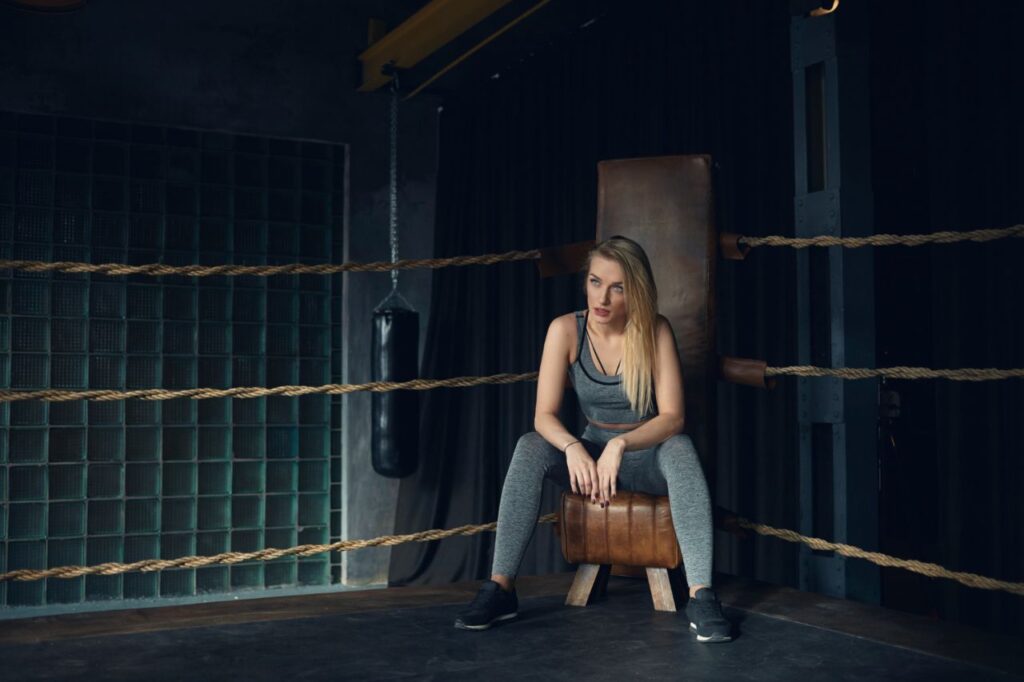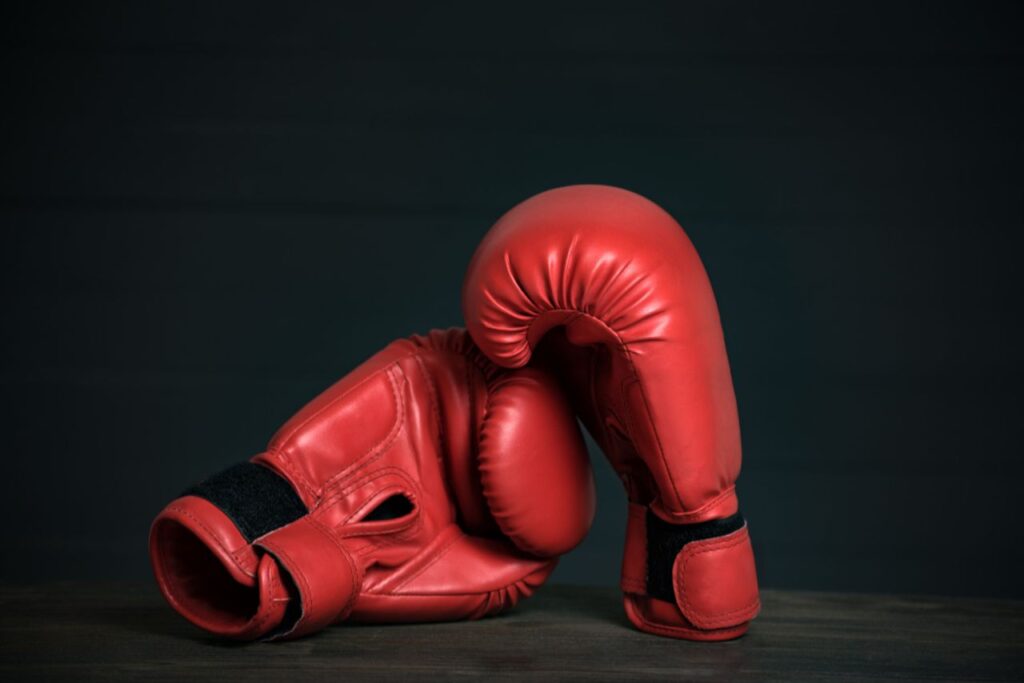Punching power is critical as it determines your ability to inflict damage on an opponent with your fists. It would be best if you had this punching power to defend yourself, win a boxing competition, or for the personal enjoyment of knowing that you can pack a punch.
While many great punchers are born with great raw punching power, you can also gain punching power if you perfect your technique, use your body, improve your strength, and keep your focus.
There are many attributes that a fighter needs to earn success in the ring - with speed, footwork and fitness being important aspects. But the key trait that most boxers crave is punching power, the ability to end a fight with one punch or hurt an opponent.
Skill, ring craft and fitness are very important in Boxing and Combat Sports. However, most athletes would love to know how to improve punching power.
Punching power is highly reliant on the rate of force development (RFD). This is a large amount of force produced in a very short amount of time.
Punching forces in amateur boxing are around 2500 N. This means if you weigh 70 kg (11 stone or 154 lbs), you will exert around 700 N of force just standing still. That makes punching force about 3.5 times body mass.
To make that even more impressive, your punch takes just six hundredths of a second (~60 ms) to throw.
Techniques To Improve Punching Power
Knowing how to throw a punch properly with added power is important not only to get your opponents respect but also to maintain balance and position to set up your next punch or move away.
Some fighters are naturally heavy-handed, but every fighter can increase punching power by implementing the following training tips and techniques.
Strengthen your legs
Most of the power in your punches come from your legs. They are the very foundation of your strength and technique, so you must strengthen your leg muscles.
Running increases the aerobic endurance in your legs, but what you should work on is anaerobic endurance which provides explosive power.
Perform activities such as cycling, squats with a medicine ball, jumps, and plyometric exercises that train the legs.
Strengthen your fists
In boxing, your hands are everything. Without them, you’re finished.
Unfortunately, hand injuries are very common, so you must strengthen your fists. It’s underrated and uncommon to condition your hands in boxing, but in martial arts, it’s not.
A great way to achieve durable fists without damaging them is to get a large tub of rice and constantly dig your hands through them with your fingertips first.
Other excellent methods are punching through water, sandbags or even placing a stack of newspapers against a wall and constantly but gently punching at the wall a few inches away.
Improve your upper body rotation
You can produce extra velocity by rotating your shoulders and torso, which in turn will increase your punching power. This is the technique that many fighters don’t or cannot utilize when they’re tired and will often have to resort to ‘arm punches’.
Your entire upper body can create the torque needed to produce a knockout, so you should concentrate on exercises that focus on this area.
Swinging a baseball bat or golf club produces the same motion as throwing a punch.
You can work on this by holding a medicine ball with both hands at chest level, straightening your arms and rotating your torso continuously from left to right.
Alex Ariza, the Strength & Conditioning coach for Manny Pacquiao, usually gets him to constantly swing a baseball bat against a heavy bag, which is also effective.
Punch through the target
Many fighters reduce their punching power by just punching their target instead of through it. The reason might be because they’re afraid of being off-balance if they miss, or it’s just a habit they’ve developed.
However, unless you’re fully committed to your punches, your cannot fully utilize all your punching power.
Practice punching through heavy bags as opposed to just punching at it, and you’ll notice a big difference. Knowing when to commit to a punch fully and when not to is just as important.
Build Up Your Speed
A great punch is generated with immense force within a short period.
Therefore, to master a heavy-hitting punch, you need to work on your speed. To build up your speed, try exercises such as shadow boxing, training with resistance bands, isometric training, etc.
Practice punching as much as you can while focusing on your breathing. The more you practice, the more your speed improves.
Relax your body
Overexerting your body can drain you of energy and affect your punching power.
Stay relaxed and allow your hands to punch in a flow.
Tightening up your muscles can add extra weight to your body. If you keep your body at ease, your punches will accurately drive towards your opponent.
Strengthen your lower body and upper body muscles, improve your rotational movement and boost your speed to generate enormous power through your punches. Remember to work on your accuracy, balance, timing, and precision to achieve great progress in different fighting styles.
Just practice with dedication and work hard.
Exercises To Increase Punching Power For Boxing

The truth about increasing punching power is there are five layers to it. First, you can’t throw powerful punches without good technique. So, that’s the first layer you have to get right.
Next, you need stability. Stability is the infrastructure you need to transfer high amounts of force through the body.
Then, it would be best if you had mobility.
Then strength.
And finally, we work our way down the force-velocity curve to produce high amounts of force fast… Aka… Power.
Fight-Specific MedBall Throw
Power is all about being able to produce force quickly. And there’s no better way to increase your punching power than by adding some light resistance to your punching movement.
That’s what this movement is going to do.
You’re going to start in your fighting stance with the medball by your chin, hop step towards the wall, and use the momentum from the top step and the force generated from your lower and upper body to propel the ball against the wall as hard as you can.
Remember: You want to keep the reps low and quality high when performing power exercises. Quality over quantity.
Fight-Specific Medball Side Toss
These punching power exercises for boxing turns things up a notch.
In this movement, you’re going to simulate cutting off your opponent in the cage or ring and catching them with a hook.
You’ll start in a staggered stance, square to the wall, hop step, explode from the hip and blast the medball against the wall.
This will work the muscles in the obliques and transverse abdominis. The development of these muscles will allow you to produce more force when throwing hooks and other punches.
Accommodating Resistance Landmine Press
The landmine press is one of my favourite strength exercises for boxing and MMA performance.
And it makes the movement 10 times more powerful when you add accommodating resistance.
For those who don’t know, accommodating resistance adds tension to the easiest part of a movement to ensure the athlete is producing force through the entire range of motion. For example, in a squat, the hardest portion of the movement is ascending out of the hole. The easiest portion is towards the top as you reach lockout.
Accommodating resistance adds tension to the lockout, which forces the athlete to accelerate through that full range of motion.
In the case of the landmine press, the accommodating resistance adds tension to the top portion of the movement. Again, this forces the athlete to accelerate through the full range of motion.
And this will carry over to increased punching power.
Accommodating resistance can be done with heavier weights. But, since our goal is power, we’re going to keep the weight light and focus on speed, so we’re training down the force-velocity curve.
Plyometric Push-Ups
Plyometric training, also known as “jump training”, are exercises in which muscles exert maximum effort and force in short bursts. The goal is not only to increase power but also speed.
The plyometric push-up is one of the most underrated drills that help to increase your punching power.
Start by getting in the standard push-up position. Then, dip down like you normally would in a standard push-up, but as you come back up, explode up so that your hands lift off the ground.
This exercise trains arm, shoulder, and pectoral strength — all parts of the body that work to increase your punching power.
You may also perform slight variants, including clapping your hands in mid-air or clapping against your chest.
Make sure to keep your core and glutes tight throughout. If you’re not strong enough just yet, you can position yourself with your knees touching the floor and work your way up.
When you’ve gained enough strength and power, you can even try lifting your feet off the ground along with your hands. This works wonders for your explosiveness and translates well into the ring.
Work The Heavy Bag
One of the most important tools in the gym for increasing punching power is the heavy bag. It’s there for a reason, and that’s for you to be able to practice unloading your strongest punches on a non-human target.
For 10 second intervals, throw your combinations and try to hit as hard as you can. That means executing your straights, hooks, and uppercuts with bad intentions. After 10 seconds, perform an active rest time of light jabs and footwork for 10-15 seconds before going hard for another 10 seconds.
Do this for the duration of three-minute rounds, resting for a minute or so in between rounds.
However, make sure you pay close attention to the technique because the proper technique will ensure that you are throwing your punches with optimal force.
Although the heavy bag is a great tool to improve your punching power, most boxers like to train on the heavy bag early in camp and taper off as camp progresses to keep their arms fresh in time for their bouts.
A legendary boxer who trained the heavy bag a lot was Roberto Duran, also known as “Hands of Stone”.
Shadowboxing
Although it may not seem like it, shadowboxing is great for increasing punching power because it forces you to focus on technique and proper execution.
The better your form is, the more efficiently you will deliver your punches. This means that more of the power you’ve developed in your muscles will wind up at the tip of your glove.
With the supervision of a trainer or boxing buddy, shadowbox in front of a mirror while paying close attention to technique and the way you throw punches.
The bonus here is the exercise should also train defence, head movement, and footwork to make you a better all-around fighter. This is one of the reasons that shadowboxing is a fundamental part of any boxing training program.
Squats with Medicine Ball
Whether you’re training for boxing or MMA, rest assured that a majority of your punching power comes from your legs.
Performing squats with a medicine ball will help give you a stronger base to work from.
Combine Squats and Lunges
Since full squats can add weight and force you up, a weight class and lunges recreate movement patterns often used in the ring. Combining split squats and lunges is a good option for efficient athletes.
Chin-Ups
Chin-ups are perfect for training your opposing (antagonist) muscles, so you’re not solely focusing on strengthening pecs, anterior deltoids, triceps, and other primary muscle groups used in punching. Instead, get the most out of it by performing them with additional resistance as you go along.
Bench Press
Will doing bench press improve your punch power?
Well, yes, it will, due to it working on your triceps and chest, and just like the overhead dumbbell press, you want to focus on explosiveness in your technique when doing this.
Make sure you combine the exercise with other recommend exercises and techniques in this blog.
Cable Machine/Resistance Bands Rotations
First off, the cable machine or resistance bands are awesome tools to use for your punch power as they can provide a good amount of resistance for your arms due to set weight or band strength.
Using this helps to keep your punch technique in check due to the rotational movements of your hips, which is essential when throwing a power punch. Using these will also help work on your chest, triceps, quad and core muscles.
Does Using A Punching Bag Increase Punching Power?

The difference between throwing weighted punches in the air and hitting a heavy bag is the bag won’t lie to you. The second you slam a hard punch into the bag, the shock of the punch travels through your body, starting at the wrist and ending in your legs.
If your technique is incorrect, you’ll walk away from the punch limping in pain. However, training on a heavy bag will increase your punching power if you’re punching correctly.
If you want to increase power and speed on your punches, engage in heavy bag training at least twice a week. Begin with a 50- to 60-pound heavy bag for the first month of training and then progress to a 100- to 120-pound bag.
The heavier the bag, the greater the shock is to your body on the punch.
A typical heavy bag workout for an amateur boxer involves three to four two-minute rounds hitting the bag, according to the RossBoxing.com website.
A professional boxer trains in three-minute rounds. Each round should have a focus.
For example, perform one round of inside power punches and another round of hooks to the areas of the bag corresponding to the head and body of an opponent. To boost the intensity of the workout, do a punch-out drill in which you throw hard, nonstop punches for 15 to 60 seconds.
Training Tips and Cautions
Because your hands consist of numerous small bones, joints and muscles, use hand wraps to protect your hands for a bag workout. The wraps provide support by securing your hands and helping to distribute the impact of a punch across your entire hand.
Instead of mitts, wear padded gloves for additional protection.
Warm-up with five to 10 minutes of light shadow boxing and dynamic stretches or moving your joints through a comfortable range of motion.
Perform a light round of two to three minutes, practising and reviewing punching form.
FAQs
Is Punching Power Genetic?
Punching power would be attributed to genetics and technique.
Learning how to throw a punch, that power would generate from the ball of your foot to the snap of your hip followed by the shoulders and the extension of the arm to the alignment of the elbow and fist, all in combination matter greatly.
How Do Boxers Increase Their Punching Power?
Hard punches need to be backed up with strong wrists and hands, and thick-grip training is one of the most practical ways to strengthen these areas. With incline presses, they often use contrast training, which applies the neurological phenomenon known as post-tetanic facilitation (PTF).
Do Push-Ups Make You Hit Harder?
Weight Training
Building strong muscles in your upper body can give you the necessary strength to land hard punches. Much of the power in your punches come from your shoulders and back, so do push-ups, pull-ups and shoulder presses to target these muscles.
Do Longer Arms Punch Harder?
The power of a punch comes from the floor, not the muscle or size of the arm. So it makes no difference the length or muscle if you don’t know how to deliver it. People who know how to punch, punch harder.
Some people are naturally gifted with an innate ability to produce power in their punches, like Tyson.
Does Punching Power Come From Legs?
Punching power is derived at first from leg drive. The amount of power the legs contribute depends on the punch thrown. The jab, the straight-forward punch performed with the non-dominant hand, is an abbreviated motion.
Your back leg contributes to the punch by driving your body forwards.
- Find a gym. Boxing gyms aren't typically found in the yellow pages, but there are resources on the internet that can lead you in the right direction. ...
- Be sure the gym is within striking distance. ...
- Be open-minded. ...
- Choose your coach carefully. ...
- Do judge the gym by its cover.
So, can boxing be self-taught? Boxing can be self-taught but it's not the quickest and most effective way to become better at the sport because you aren't able to tap into the knowledge of a boxing coach who would be able to help you one to one.
Best Age to Start
Specialists in sports medicine believe that boxing classes are better to start from 9-10 years. Starting too early could result in putting the student off, as boxing is hard work and not always as fun as team sports, such as football or rugby.

